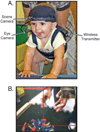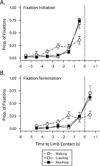Head-mounted eye tracking: a new method to describe infant looking
- PMID: 22023310
- PMCID: PMC3218200
- DOI: 10.1111/j.1467-8624.2011.01670.x
Head-mounted eye tracking: a new method to describe infant looking
Abstract
Despite hundreds of studies describing infants' visual exploration of experimental stimuli, researchers know little about where infants look during everyday interactions. The current study describes the first method for studying visual behavior during natural interactions in mobile infants. Six 14-month-old infants wore a head-mounted eye-tracker that recorded gaze during free play with mothers. Results revealed that infants' visual exploration is opportunistic and depends on the availability of information and the constraints of infants' own bodies. Looks to mothers' faces were rare following infant-directed utterances but more likely if mothers were sitting at infants' eye level. Gaze toward the destination of infants' hand movements was common during manual actions and crawling, but looks toward obstacles during leg movements were less frequent.
© 2011 The Authors. Child Development © 2011 Society for Research in Child Development, Inc.
Figures




References
-
- Adolph KE. Learning in the development of infant locomotion. Monographs of the Society for Research in Child Development. 1997;62 - PubMed
-
- Adolph KE. Specificity of learning: Why infants fall over a veritable cliff. Psychological Science. 2000;11:290–295. - PubMed
-
- Adolph KE, Badaly D, Garciaguirre JS, Sotsky R. 15,000 steps: Infants' locomotor experience. 2010 Manuscript in revision.
-
- Aslin RN, McMurray B. Automated corneal-reflection eye tracking in infancy: Methodological developments and applications to cognition. Infancy. 2004;6:155–163. - PubMed
Publication types
MeSH terms
Grants and funding
LinkOut - more resources
Full Text Sources
Medical

